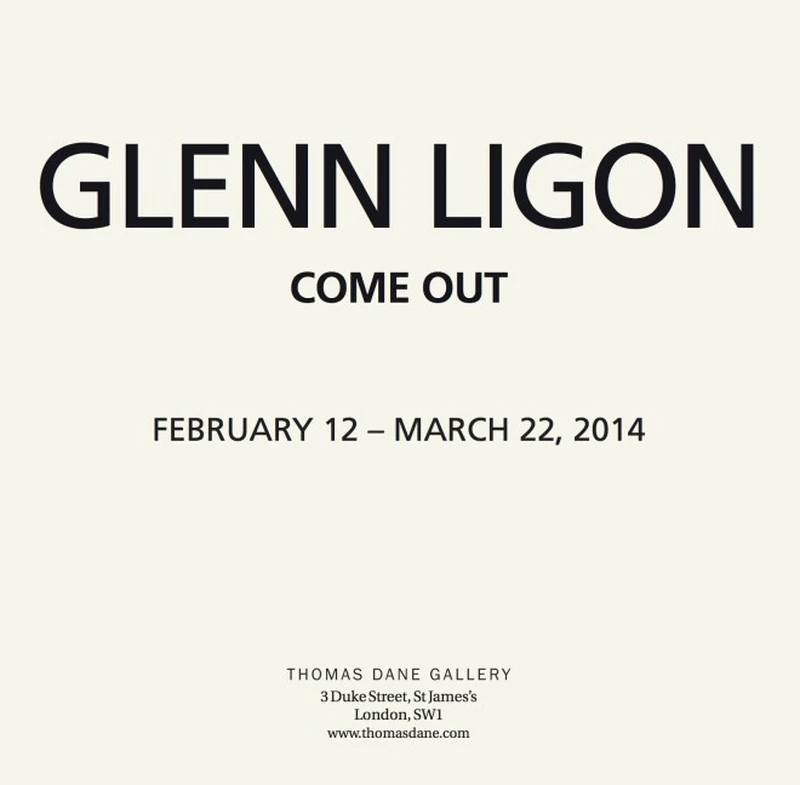Glenn Ligon: Come Out
12 Feb-22 Mar 2014


For his third exhibition at the gallery, Glenn Ligon has composed an ensemble of three monumental screen-printed paintings based on 'Come Out' (1966), one of Steve Reich's early taped-speech works. In this visionary piece Reich, a pioneer of minimal and process music, used the voice of Daniel Hamm one of six young men charged with the murder of a shopkeeper in Harlem in the spring of 1964. The young men were severely beaten by the police while in jail and denied the use of their own lawyers. The case of the 'Harlem Six' quickly became a cause célèbre, with politicians, civil rights activists and artists commenting on indiscriminate police brutality against black citizens and wondering, in the words of James Baldwin, "where is the civilization and where, indeed, is the morality that can afford to destroy so many".
Reich became involved with the Harlem Six when he was asked to compose a piece for a benefit concert at Town Hall in New York City in 1966. He listened to the taped testimony of the defendants and focused on an excerpt of Hamm saying: "I had to, like, open the bruise up, and let some of the bruise blood come out to show them". Reich uses this as a repeated verse at the beginning of the piece. Reich then shortens and the verse to "Come out to show them", repeated on two channels over and over again, first in unison and then with one channel gradually going out of synch with the other. As the phrases begin to shift they create an increasing reverberation that turns into a canon - a hypnotic 'round'- breaking further apart and destroying the intelligibility of the words.
In the paintings that make up the exhibition Come Out, Ligon has isolated the same phrase as Reich and uses it to create densely layered canvases where "Come out to show them" is repeatedly screen-printed and super-imposed onto the picture plane. Echoing a characteristic of Reich's music in which words are gradually shifting and re-positioning without any sense of climax but with a very controlled sense of 'progression', Ligon increases the number of silkscreen layers in each painting until the words verge on abstraction. By placing the three very large paintings in the exhibition in the order in which they were made, emphasizing the increasing density of the painting's surfaces, Ligon references the 'wall of sound' musical production technique made famous in the early 1960s by record producer Phil Spector, as well as Reich's interests in contrapuntal compositional technique and African drumming.
The strategies employed in these paintings - where a visual continuum shifts little by little, inviting the viewer to concentrate on these slowly changing effects - is not new to Ligon's work. For instance, some of his earliest text paintings use a single sentence repeated stenciled in black oilstick down the surface of door shaped panel, the text turns into abstraction by the same act of stenciling that creates it. The paintings in this exhibition also move speech towards abstraction, but in the end, the words remain legible, suggesting that the social conditions that prompted Reich's composition remain, in some sense, unfinished business.
Glenn Ligon lives and works in New York. Ligon received a Bachelor of Arts from Wesleyan University in 1982, and attended the Whitney Museum Independent Study Program in 1985. A mid-career retrospective of Ligon's work, Glenn Ligon: AMERICA, organized by Scott Rothkopf, opened at the Whitney Museum of American Art in March 2011. The exhibition traveled to the Los Angeles County Museum of Art in the fall of 2011, and to the Modern Art Museum of Fort Worth in early 2012. Ligon has been the subject of solo museum exhibitions at the Power Plant in Toronto, the Walker Art Center in Minneapolis, the Studio Museum in Harlem, the Institute of Contemporary Art in Philadelphia and the Kunstverein Munich. His work was included in Documenta XI in 2002, and the 1991 and 1993 Whitney Biennials. Glenn Ligon will have an exhibition at Camden Arts Cenre, London in October 2014.
An opening reception will take place on 11 February from 6-8pm at 3 Duke Street, St. James's.